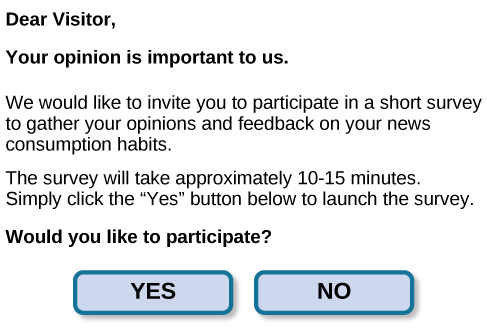Surveys
Often, psychologists develop surveys as a means of gathering data.
survey
Surveys are lists of questions to be answered by research participants, and can be delivered as paper-and-pencil questionnaires, administered electronically, or conducted verbally.
Generally, the survey itself can be completed in a short time, and the ease of administering a survey makes it easy to collect data from a large number of people. You have probably even participated in some already—oftentimes surveys are given by retailers after a customer experience to learn more about reactions to a product or a service.

How Psychologists Use Surveys
Surveys are most often used in descriptive research, helping psychologists collect information about people’s attitudes, opinions, or behaviors.
However, they can also support:
- Correlational research, such as examining the relationship between age and voting behavior
- Experimental research, to collect participant information (e.g., demographics or self-reported outcomes)
Because surveys can reach large groups quickly, they are ideal for identifying patterns and trends across populations.
Samples and Populations
When psychologists conduct surveys, they typically cannot study every individual in the population they care about. Instead, they study a sample—a smaller group chosen to represent the larger population.
- Population: The full group a researcher wants to understand (e.g., all U.S. college students).
- Sample: A subset of that group (e.g., 500 students from several universities).
Researchers analyze the sample’s responses and generalize the findings to the larger population—especially when the sample is large and diverse.
They often use measures of central tendency (mean, median, and mode) to summarize what a “typical” response looks like.
Strengths of Surveys
- Efficient: Surveys can be distributed to thousands of people quickly and inexpensively.
- Versatile: Questions can cover nearly any topic, from political beliefs to mental health habits.
- Generalizable: Large, diverse samples allow researchers to draw conclusions about entire populations.
For example, a nationwide survey on stress among college students can provide insight that no small case study could match.
Limitations of Surveys
- Limited depth: While surveys reach many people, they collect less detailed information from each individual compared to methods like interviews or case studies.
- Inaccurate self-reports: Participants may lie, misremember, or answer in socially desirable ways.
- For instance, people might underreport their alcohol use or overstate how often they exercise.
- Question wording bias: Poorly phrased or leading questions can distort results.
Because of these limitations, psychologists must design surveys carefully—using clear, neutral wording and ensuring participant anonymity to encourage honesty.